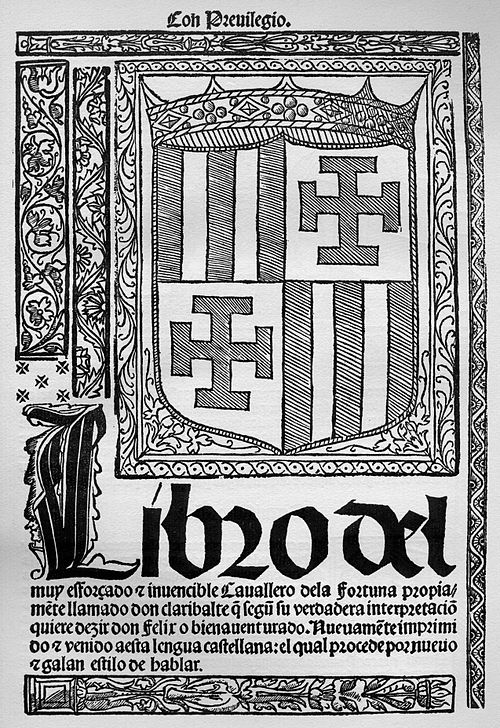
Gonzalo Fernández de Oviedo y Valdés (August 1478 – 1557), commonly known asOviedo, was a Spanish soldier, historian, writer, botanist and colonist. Oviedo participated in the Spanish colonization of theWest Indies, arriving in the first few years afterChristopher Columbus became the first European to arrive at the islands in 1492. Oviedo's chronicleHistoria general de las Indias, published in 1535 to expand on his 1526 summaryLa Natural hystoria de las Indias (collectively reprinted, three centuries after his death, asHistoria general y natural de las Indias), forms one of the few primary sources about it. Portions of the original text were widely read in the 16th century in Spanish, English, Italian and French editions, and introduced Europeans to thehammock, thepineapple, andtobacco as well as creating influential representations of the colonized peoples of the region.
Oviedo was born inMadrid of anAsturian lineage and educated in the court ofFerdinand andIsabella. He was a page to their son, theInfanteJohn, Prince of Asturias, from about the age of fourteen until the Prince's death in 1497, and then Oviedo went to Italy for three years before returning to Spain as a bureaucrat to the emerging Castilian imperial project. Oviedo married first Margarite de Vergara, who died in childbirth, and then Isabel de Aguilar. Isabel and their multiple children later died within several years of joining Oviedo in America.[1]
In 1514 Oviedo was appointed supervisor of gold smelting atSanto Domingo, and on his return to Spain in 1523 was appointed historian of the West Indies. He paid five more visits to the Americas before his death, inValladolid in 1557.[2] At one point he was placed in charge of theFortaleza Ozama, inSanto Domingo,Dominican Republic, where there is a large statue of him, a gift to that country from a King of Spain.

Oviedo's first literary work was achivalric romance entitled,Libro del muy esforzado e invencible caballero Don Claribalte [es] (Book of the very striving and invincible knight Don Claribalte). It was published in 1519 inValencia by Juan Viñao, one of the prominent printers of that time. In the foreword, dedicated toFerdinand of Aragón, Duke of Calabria (not to be confused with the KingFerdinand II of Aragon), Oviedo relates that the work had been conceived and written while he was in Santo Domingo. Therefore, it seems that this was the first Spanish literary work created in theNew World.[3]
Oviedo later wrote two extensive works of permanent value, which for the most part were not published until three centuries after his death:La historia general y natural de las Indias andLas Quinquagenas de la nobleza de España. TheQuinquagenas is a collection of quaint, moralizing anecdotes in which Oviedo indulges in much lively gossip concerning eminent contemporaries. It was first published in Madrid in 1880, edited by Vicente de la Fuente.[2]

Oviedo first published a smaller work,La Natural hystoria de las Indias, which was published at his expense on 15 February 1526 in Toledo.[4] This is often described as theSumario.[1] An Italian translation of this appeared in Venice in 1534, with French editions from 1545 and English ones from 1555, although there was no second Spanish edition until 1749. This 108 page work contained only a few illustrations, although it did include one of a hammock.[4] In 1535 the first part of the longer and more fully illustratedHistoria general de las Indias was printed in Seville, and Oviedo had outlined two subsequent parts. He continued to work in both Santo Domingo and Spain on subsequent parts and to revise the first part until his death in 1557.[5] That year, Fernández de Cordoba published the entirety ofHistoria General's first volume inValladolid, as well as the first two-thirds of the second volume. The remainder, however, languished in Oviedo's absence.[6] The manuscript was kept in the Monserrate monastery for many years and then the Royal Academy of History. Surviving portions were used byJosé Amador de los Ríos in preparing an 1851 edition titledNatural y General Hystoria de las Indias.[5][7] Although some portions were known to be missing by 1780, further large portions of the manuscript which were present then are no longer in Madrid. A paper by Jesús Carrillo in the Huntington Library Quarterly described the circumstances of the disposal as 'unknown'.[5] Some were sold, by a London bookseller,Maggs toHenry E. Huntington in 1926 and are now held in theHuntington Library.[8] A transcription of part of the manuscript was made in Seville by Andres Gasco before 1566 and two of the three volumes of this transcription are held in the library of the Royal Palace of Madrid.[5]

TheHistoria, though written in a diffuse style, furnishes a mass of information collected at first hand.Las Casas, the fellow contemporary chronicler of the Spanish colonization of the Caribbean, denounced Oviedo as "one of the greatest tyrants, thieves, and destroyers of the Indies, whoseHistoria contains almost as many lies as pages".[10] The incomplete Seville edition was widely read in the English and French versions published by Eden and Poleur, respectively, in 1555 and 1556.[2] It is through theHistoria that Europeans came to learn about the hammock, pineapple, tobacco, andbarbecue, among other things used by the Native Americans that he encountered. The first illustration of a pineapple is credited to him.[11]
In zoology, theGeneral History of the Indies is of particular interest for its descriptions of Hispaniolan animals, including some that becameextinct between Oviedo's time and the development of the modern science fromLinnaeus andCuvier. The only land mammals of the island according to Oviedo, besidesrats andmice (which Oviedo believed native, but were introduced accidentally by Europeans), were:
 One or more of the preceding sentences incorporates text from a publication now in thepublic domain: Chisholm, Hugh, ed. (1911). "Oviedo y Valdés, Gonzalo Fernández de".Encyclopædia Britannica. Vol. 20 (11th ed.). Cambridge University Press. p. 391.
One or more of the preceding sentences incorporates text from a publication now in thepublic domain: Chisholm, Hugh, ed. (1911). "Oviedo y Valdés, Gonzalo Fernández de".Encyclopædia Britannica. Vol. 20 (11th ed.). Cambridge University Press. p. 391.{{cite book}}: CS1 maint: location missing publisher (link)